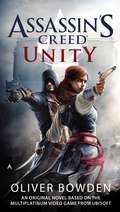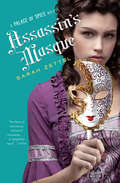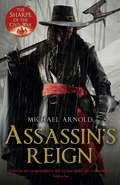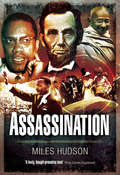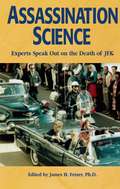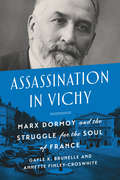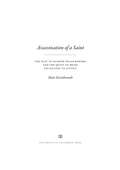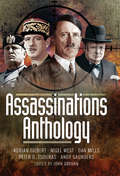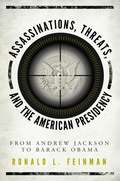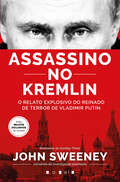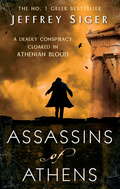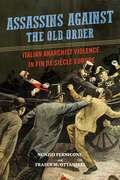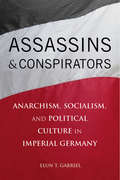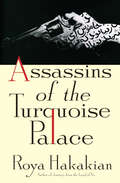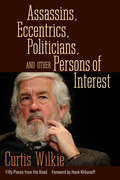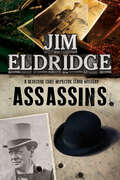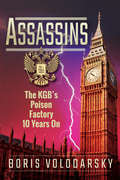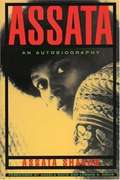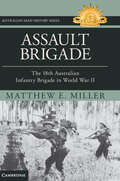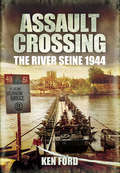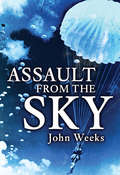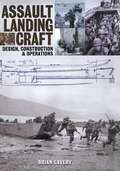- Table View
- List View
Assassin's Creed: Unity
by Oliver Bowden1789: The magnificent city of Paris sees the dawn of the French Revolution. The cobblestone streets run red with blood as the people rise against the oppressive aristocracy. But revolutionary justice comes at a high price... At a time when the divide between the rich and poor is at its most extreme, and a nation is tearing itself apart, a young man and woman fight to avenge all they have lost. Soon Arno and Élise are drawn into the centuries-old battle between the Assassins and the Templars--a world with dangers more deadly than they could ever have imagined.
Assassin's Masque (Palace of Spies #3)
by Sarah ZettelThings are turning around for seventeen-year-old Peggy Fitzroy, a once-orphaned spy. Her father is back from the dead, and her unwanted engagement has been called off for good. But when a mysterious veiled woman shows up, Peggy uncovers a fresh slew of questions about her past, present, and future. Now Peggy is back at the palace, unsure of the loyalties she thought she held. With the Jacobite uprising stalking ever closer to the throne, it's imperative that Peggy discover who she can really trust. Can she save herself and the royal family, or is she doomed as a pawn in this most deadly game?
Assassin's Reign: Book 4 of The Civil War Chronicles (Stryker)
by Michael ArnoldAssassin's Reign, the fourth in The Civil War Chronicles, Michael Arnold's acclaimed series of historical thrillers, sees battle-scarred hero Captain Stryker, 'the Sharpe of the Civil War', in the fight of his life.'Stands in comparison with the best of Cornwell' Yorkshire PostThe forces of King Charles are victorious; their Parliamentarian enemies in deep crisis. In the west, the crucial port city of Bristol has fallen, and Royalist eyes fall quickly upon neighbouring Gloucester. Its walls are weak, its garrison under strength, and its governor - Sir Edward Massie - suspected of harbouring sympathy for the King.Stryker and his men are with the army as it converges on Gloucester, still reeling from the loss of a close friend at the bloody Battle of Stratton. Ordered to infiltrate the rebel city on a mission to discover whether Massie will indeed surrender, Stryker reluctantly embarks upon his most desperate mission yet. But Gloucester's defenders are more resolute than any had imagined, and catastrophe soon befalls him. With his life seemingly forfeit, Stryker is spared by an unlikely saviour; Vincent Skaithlocke, his former commander. The mercenary has returned to England to fight for Parliament, and offers Stryker his protection. As old friends adjust to life fighting for opposing sides, Stryker begins to question his own loyalties . . . but a chance discovery makes him realise that all in Gloucester is not what it seems, for a hidden menace threatens his own life, and that of King Charles himself.
Assassin: Patricia Finney is Writing as Grace Cavendish
by Grace CavendishWHEN MARGARET CAVENDISH, one of Elizabeth I’s Gentlewomen of the Bedchamber, lost her life in a bungled attempt to kill the Queen, her daughter, Lady Grace, became a protégée to the monarch, who takes Grace under her wing. Now Grace, a spunky girl who romps through the gardens with the laundry maids and court tumblers and rolls her eyes at her fellow ladies, chronicles the court intrigues that swirl around her... It’s the spring of 1569 and 13-year-old Lady Grace, the youngest lady-in-waiting to the Queen, finds herself at a glittering ball choosing amongst three suitors. But the Queen’s generosity turns deadly as threats, dark secrets, and even murder descend on the Tudor court. And it is up to Grace to use her intelligence, stealth, and curious nature to solve the mystery that threatens the very lifeblood of England.
Assassination
by Miles HudsonThe assassination of political, religious and military leaders, often dictators, is frequently seen as the short cut to solving a particular problem. The author takes issue with this argument. Examining a series of linked assassinations together with their causes and effects, he seeks to demonstrate that in many cases the killings have produced unforeseen and unintended consequences that all too often result in the opposite result to that desired. His case studies, arranged intriguingly in pairs, cover such diverse characters as Julius Caesar and Thomas Becket, Gandhi and Jesus Christ, Tsar Alexander II and Abraham Lincoln, Michael Collins and Field Marshal Sir Henry Wilson, and Martin Luther King and Malcolm X.This is an absorbing, controversial and informative study.
Assassination Science
by Ph.D. James H. FetzerIf you have ever been tempted to believe that President Kennedy was killed by a lone,demented gunman named Lee Harvey Oswald, then Assassination Science is the one book which will convince you, beyond any reasonable doubt, that there was indeed a conspiracy and a cover-up. Completely lacking the wild speculation that have marred some books on the shooting of JFK, Assassination Science sticks to the hard facts, interpreted by medical and scientific expertise.
Assassination in Vichy: Marx Dormoy and the Struggle for the Soul of France
by Gayle Brunelle Stephanie Annette Finley-CroswhiteDuring the night of 25 July 1941, assassins planted a time bomb in the bed of the former French Interior Minister, Marx Dormoy. The explosion on the following morning launched a two-year investigation that traced Dormoy’s murder to the highest echelons of the Vichy regime. Dormoy, who had led a 1937 investigation into the “Cagoule,” a violent right-wing terrorist organization, was the victim of a captivating revenge plot. Based on the meticulous examination of thousands of documents, Assassination in Vichy tells the story of Dormoy’s murder and the investigation that followed. At the heart of this book lies a true crime that was sensational in its day. A microhistory that tells a larger and more significant story about the development of far-right political movements, domestic terrorism, and the importance of courage, Assassination in Vichy explores the impact of France’s deep political divisions, wartime choices, and post-war memory.
Assassination of a Saint: The Plot to Murder Óscar Romero and the Quest to Bring His Killers to Justice
by Matt EisenbrandtOn March 24, 1980, the assassination of El Salvador's Archbishop Óscar Romero rocked that nation and the world. Despite the efforts of many in El Salvador and beyond, those responsible for Romero's murder remained unpunished for their heinous crime. Assassination of a Saint is the thrilling story of an international team of lawyers, private investigators, and human-rights experts that fought to bring justice for the slain hero. Matt Eisenbrandt, a lawyer who was part of the investigative team, recounts in this gripping narrative how he and his colleagues interviewed eyewitnesses and former members of death squads while searching for evidence on those who financed them. As investigators worked toward the only court verdict ever reached for the murder of the martyred archbishop, they uncovered information with profound implications for El Salvador and the United States.
Assassination!: The Brick Chronicle of Attempts on the Lives of Twelve US Presidents
by Brendan Powell SmithCreator of the bestselling The Brick Bible: A New Spin on the Old Testament and The Brick Bible: The New Testament, author Brendan Powell Smith offers a new take on American history. For more than a decade, Smith has honed his masterful work using LEGO(R) to re-create scenes from the Bible. Now, he turns his attention to unforgettable US presidential assassinations, both fatal and failed. Rediscover some of the most profound attacks that have occurred throughout US history involving the notorious assassinations on Abraham Lincoln, William McKinley, and John F. Kennedy. But did you also know that Richard Paul Pavlick sought to assassinate President Kennedy in 1960, though at the last minute he suddenly changed his mind? Or, that an unknown assailant desperately tried to murder Lincoln just eight months before his fatal night at Ford's Theatre? In addition, Smith reveals failed murder attempts against such presidents as Gerald Ford, Richard Nixon, Bill Clinton, and most recently, the 2011 attempt against President Barack Obama.With over four hundred highly detailed illustrations, Smith captivates the authenticity of these assassinations (re-creating famous photographs and oral history) while simultaneously demonstrating a creative new medium. Whether a historian or a LEGO(R) enthusiast, readers of all ages will surely be enthralled with Brendan Powell Smith's latest brick creation!
Assassinations Anthology: Plots and Murders That Would Have Changed the Course of WW2
by Peter G. Tsouras Adrian Gilbert Nigel West Andy Saunders Dan MillsA fascinating look at what might have happened had historical assassination attempts succeeded. If Hitler had died at any stage in the Second World War, would Germany have immediately sued for peace, or would the generals have taken over and fought a far more practical war than the obdurate Führer? Equally intriguing is the possible failed assassination attempt on General de Gaulle on British soil. Who, one wonders, was behind that scheme, and how would Anglo-French relations have developed if he had been killed? In Assassinations Anthology, a number of well-known authors and historians look at past events where key individuals were involved in either attempts on their lives, or strange incidents occurred which, had they led to their deaths, might have radically affected the outcome of the war. Events surrounding Hitler and Operation Valkyrie, Stalin and Jan Smuts are investigated, as well as the peculiar circumstances relating to the theft of a valuable Gainsborough painting. Just how great a role did the Government&’s Chief Whip, David Margesson, play in persuading the MPs to accept the unpopular Winston Churchill as Prime Minister, and what would have happened if Margesson had been killed when the Gainsborough disappeared? It is fascinating stuff. Grounded in actual events, the various scenarios portrayed in this collection examine the likely chain of events that would have followed if the assassination attempts had succeeded. A few inches, a few minutes—that was all the difference between life and death, and between the past that we know and one that we can only imagine.
Assassinations, Threats, and the American Presidency: From Andrew Jackson to Barack Obama
by Ronald L. FeinmanThroughout American history, Presidents and Presidential candidates have faced countless assassination threats and attempts on their lives. These threats have extended not only to sitting Presidents and candidates but also to Presidents-elect and former Presidents. Assassinations, Threats, and the American Presidency: From Andrew Jackson to Barack Obama walks through Presidential history, looking at the countless assassination threats and attempts that have occurred throughout history. Historian Ronald L. Feinman discusses the Presidencies of sixteen Presidents, as well as three important candidates and five living Presidents today, and how they were directly threatened with assassination, ranging from the first known threat to Andrew Jackson in 1833, to threats to Barack Obama in late 2014. All nineteen of these Presidents and candidates were threatened with assassination--six being killed, three wounded, and ten unhurt. Additionally, he reveals information about some failed attempts, which, had they been successful, could have resulted in fifteen different men who would have become President of the United States. Which ones would have been able to fill the responsibilities? Which ones would have been disastrous in the Oval Office? Assassination attempts, both successful and failures have been part of our political culture for over 180 years, and the problem of Presidential security, safety and protection remains a serious problem today. With the President being faced with countless death threats, the Secret Service and FBI are forced to employ all kinds of technological methods to protect our Chief Executive and his family, as well as other top officials in the line of succession. Feinman brings to light how these agencies have grown, both technologically and physically, to counter these attacks. He, also, sheds light on how these threats to our Presidency have devastated, changed, and grown our United States into what it is today.
Assassino no Kremlin: O Relato Explosivo do Reinado de Terror de Vladimir Putin
by John SweeneyUm livro que põe a descoberto o governo impiedoso e a máquina de matar do Kremlin, e coloca questões urgentes sobre como o mundo deve responder. Com 30 anos de experiência em ambientes de guerra, o premiado jornalista John Sweeney faz neste livro um relato da ambição desmedida e da desumanidade de Vladimir Putin, desde os golpes levados a cabo no coração da Rússia até às atrocidades cometidas pelo exército russo na Chechénia, à anexação da Crimeia e à invasão da Ucrânia, um dos atos mais hediondos de agressão da história moderna. Recorrendo a testemunhos daqueles que sofreram sob o poder de Putin, vemos o heroísmo da oposição russa, a bravura da resistência ucraniana e a brutalidade com que o Kremlin responde a atos de desafio, assassinando ou pondo fora do caminho os críticos e opositores, não se detendo perante nada para atingir os seus objetivos imperialistas. «As palavras têm poder. Vladimir Putin tem medo da verdade.» ALEXEI NAVALNY, líder da oposição russa, atualmente preso pelo regime do Kremlin «Uma obra que traça o percurso sangrento de Vladimir Putin.» THE TIMES «Um livro que escrutina os pecados do líder do regime da Rússia.» IPAPER «Vladimir Putin é um presidente tão perverso e desordeiro quanto José Estaline.» BORIS NEMTSOV, líder da oposição russa assassinado em 2015 «Ninguém no mundo vai perdoar Vladimir Putin por matar pessoas inocentes.» VOLODYMYR ZELENSKY, presidente da Ucrânia «Um ditador, empenhado em reconstruir um império, nunca destruirá o amor de um povo pela liberdade.» JOE BIDEN, presidente dos Estados Unidos da América
Assassins Of Athens: Number 2 in series (Chief Inspector Andreas Kaldis Mystery #2)
by Jeffrey SigerWhen the body of a boy from one of Greece's most prominent families turns up in a dumpster in one of Athens' worst neighbourhoods, Chief Inspector Andreas Kaldis - now head of the Special Crimes Division - is certain there's a message in the murders. But who sent it - and why?Andreas' search for answers takes him deep into the sordid, criminal side of Athens nightlife and on to the glittering society world, where age-old frictions between old and new money breed jealousy, murder, revenge, revolutionaries and dangerous, if not deadly, truths...
Assassins against the Old Order: Italian Anarchist Violence in Fin de Siecle Europe
by Nunzio Pernicone Fraser OttanelliThe image of the anarchist assassin haunted the corridors of power and the popular imagination in the late nineteenth century. Fear spawned a gross but persistent stereotype: a swarthy "Italian" armed with a bloody knife or revolver and bred to violence by a combination of radical politics, madness, innate criminality, and poor genes. That Italian anarchists targeted--and even killed--high-profile figures added to their exaggerated, demonic image. Nunzio Pernicone and Fraser Ottanelli dig into the transnational experiences and the historical, social, cultural, and political conditions behind the phenomenon of anarchist violence in Italy. Looking at political assassinations in the 1890s, they illuminate the public effort to equate anarchy's goals with violent overthrow. Throughout, Pernicone and Ottanelli combine a cutting-edge synthesis of the intellectual origins, milieu, and nature of Italian anarchist violence with vivid portraits of its major players and their still-misunderstood movement. A bold challenge to conventional thinking, Assassins against the Old Order demolishes a century of myths surrounding anarchist violence and its practitioners.
Assassins and Conspirators: Anarchism, Socialism, and Political Culture in Imperial Germany
by Elun GabrielOver the course of the German Empire the Social Democrats went from being a vilified and persecuted minority to becoming the largest party in the Reichstag, enjoying broad-based support. But this was not always the case. In the 1870s, government mouthpieces branded Social Democracy the "party of assassins and conspirators" and sought to excite popular fury against it. Over time, Social Democrats managed to refashion their public image in large part by contrasting themselves to anarchists, who came to represent a politics that went far beyond the boundaries of acceptable behavior. Social Democrats emphasized their overall commitment to peaceful change through parliamentary participation and a willingness to engage their political rivals. They condemned anarchist behavior—terrorism and other political violence specifically—and distanced themselves from the alleged anarchist personal characteristics of rashness, emotionalism, cowardice, and secrecy. Repeated public debate about the appropriate place of Socialism in German society, and its relationship to anarchist terrorism, helped Socialists and others, such as liberals, political Catholics, and national minorities, cement the principles of legal equality and a vigorous public sphere in German political culture. Using a diverse array of primary sources from newspapers and political pamphlets to Reichstag speeches to police reports on anarchist and socialist activity, this book sets the history of Social Democracy within the context of public political debate about democracy, the rule of law, and the appropriate use of state power. Gabriel also places the history of German anarchism in the larger contexts of German history and the history of European socialism, where its importance has often been understated because of the movement's small size and failure to create a long-term mass movement.
Assassins of the Turquoise Palace
by Roya HakakianOn the evening of September 17, 1992, eight leading members of the Iranian and Kurdish opposition had gathered at a little-known restaurant in Berlin when two darkly-clad men burst through the entrance. Within moments, the roar of a machine gun filled the air. Two rounds of fire and four single shots later, four of the men were dead. One of the survivors of that shooting, along with the widow of one of the victims and a handful of reporters, attorneys, and fellow exiles, began a crusade that would not only pit them against Tehran but against some of the greatest powers in Germany. When an undeterred federal prosecutor, and an endlessly patient chief judge, took over the case, a historic verdict followed which shook both Europe and Iran, and achieved something few could have predicted-justice. Roya Hakakian’s The Assassins of the Turquoise Palace is an incredible book of history and reportage, and an unforgettable narrative of heroism and justice.
Assassins, Eccentrics, Politicians, and Other Persons of Interest: Fifty Pieces from the Road
by Curtis WilkieWriting as a newspaper reporter for nearly forty years, Curtis Wilkie covered eight presidential campaigns, spent years in the Middle East, and traveled to a number of conflicts abroad. However, his memory keeps turning home and many of his most treasured stories transpire in the Deep South. He called his native Mississippi, “the gift that keeps on giving.” For Wilkie, it represented a trove of rogues and racists, colorful personalities and outlandish politicians who managed to thrive among people otherwise kind and generous. Assassins, Eccentrics, Politicians, and Other Persons of Interest collects news dispatches and feature stories from the author during a journalism career that began in 1963 and lasted until 2000. As a young reporter for the Clarksdale Press Register, he wrote many articles that dealt with the civil rights movement, which dominated the news in the Mississippi Delta during the 1960s.Wilkie spent twenty-six years as a national and foreign correspondent for the Boston Globe. One of the original “Boys on the Bus” (the title of a best-selling book about journalists covering the 1972 presidential campaign), he later wrote extensively about the winning races of two southern Presidents, Jimmy Carter and Bill Clinton. Wilkie is known for stories reported deeply, rife with anecdotes, physical descriptions, and important background details. He writes about the notorious, such as the late Hunter S. Thompson, as well as more anonymous subjects whose stories, in his hands, have enduring interest. The anthology collects pieces about several notable southerners: Ross Barnett; Byron De La Beckwith and Sam Bowers; Billy Carter; Edwin Edwards and David Duke; Trent Lott; and Charles Evers. Wilkie brings a perceptive eye to people and events, and his eloquent storytelling represents some of the best journalistic writing.
Assassins: A British Mystery Series Set In 1920s London (The Detective Chief Inspector Stark Mysteries #1)
by Jim EldridgeA professional assassin stalks London&’s streets in the first historical mystery featuring Scotland Yard&’s Detective Chief Inspector Stark. London, 1921. The Great War has recently ended and tensions in England are high. Now, prominent Cabinet minister Lord Amersham has been shot dead outside his Regent&’s Park home. With two bullets to the chest and one to the forehead, all signs point to a professional hit. Charged with solving one of the most sensitive and high-profile cases Scotland Yard has ever faced, DCI Paul Stark is under pressure to get the job done quickly. Amersham&’s colleague Winston Churchill, Secretary of State for the Colonies, is convinced the Bolsheviks are responsible. Stark&’s contemporaries at Special Branch believe there&’s a connection to Government talks about Irish Home Rule. And others believe the motive could be connected to Lord Amersham&’s rather scandalous private life . . . When a second crime takes place—another murder committed by an expert marksman at close range—the case takes a terrifying turn and puts Stark right in the middle of an international crisis. &“Besides providing interesting nuggets of history, Eldridge depicts his lead characters with complexity and compassion, auguring well for this series kickoff.&” —Kirkus Reviews
Assassins: The KGB's Poison Factory 10 Years On
by Boris VolodarskyA look at the events surrounding the 2006 poisoning of a former Russian security officer in Great Britain.In November, 1998, Alexander Litvinenko, a former lieutenant colonel of the Russian security service or FSB, along with several former colleagues, publicly stated that their superiors had instigated an assassination attempt on a Russian tycoon and oligarch. Following his subsequent arrest and failed trials, Litvinenko fled to London where, having been granted asylum, he worked as a journalist and writer, as well as acting as a consultant for the British intelligence services.Eight years later, Litvinenko’s past caught up with him when he was assassinated in London. On November 1, 2006, Litvinenko was suddenly taken ill and hospitalized. He passed away twenty-two days later. Significant amounts of a rare, highly toxic element were subsequently found in his body. Before his death, Litvinenko had said, “You may succeed in silencing one man, but the howl of protest from around the world, Mr. Putin, will reverberate in your ears for the rest of your life.”Author Boris Volodarsky, who was consulted by the Metropolitan Police during the investigation and remains in close contact with Litvinenko’s widow, details the events surrounding Litvinenko’s murder. Volodarsky updates the story, referring to the findings of the official British inquiry, on the release of which Prime Minister David Cameron condemned Putin for presiding over “state sponsored murder.”The author proves that the Litvinenko’s poisoning is just one of many. Some of these assassinations or attempted assassinations are already known; others are revealed by him for the first time.
Assassins: The KGB's Poison Factory 10 Years On
by Boris VolodarskyA look at the events surrounding the 2006 poisoning of a former Russian security officer in Great Britain.In November, 1998, Alexander Litvinenko, a former lieutenant colonel of the Russian security service or FSB, along with several former colleagues, publicly stated that their superiors had instigated an assassination attempt on a Russian tycoon and oligarch. Following his subsequent arrest and failed trials, Litvinenko fled to London where, having been granted asylum, he worked as a journalist and writer, as well as acting as a consultant for the British intelligence services.Eight years later, Litvinenko’s past caught up with him when he was assassinated in London. On November 1, 2006, Litvinenko was suddenly taken ill and hospitalized. He passed away twenty-two days later. Significant amounts of a rare, highly toxic element were subsequently found in his body. Before his death, Litvinenko had said, “You may succeed in silencing one man, but the howl of protest from around the world, Mr. Putin, will reverberate in your ears for the rest of your life.”Author Boris Volodarsky, who was consulted by the Metropolitan Police during the investigation and remains in close contact with Litvinenko’s widow, details the events surrounding Litvinenko’s murder. Volodarsky updates the story, referring to the findings of the official British inquiry, on the release of which Prime Minister David Cameron condemned Putin for presiding over “state sponsored murder.”The author proves that the Litvinenko’s poisoning is just one of many. Some of these assassinations or attempted assassinations are already known; others are revealed by him for the first time.
Assata: An Autobiography
by Angela Y. Davis Assata Shakur Lennox S. HindsOn May 2, 1973, Black Panther Assata Shakur (aka JoAnne Chesimard) lay in a hospital, close to death, handcuffed to her bed, while local, state, and federal police attempted to question her about the shootout on the New Jersey Turnpike that had claimed the life of a white state trooper. Long a target of J. Edgar Hoover's campaign to defame, infiltrate, and criminalize Black nationalist organizations and their leaders, Shakur was incarcerated for four years prior to her conviction on flimsy evidence in 1977 as an accomplice to murder. This intensely personal and political autobiography belies the fearsome image of JoAnne Chesimard long projected by the media and the state. With wit and candor, Assata Shakur recounts the experiences that led her to a life of activism and portrays the strengths, weaknesses, and eventual demise of Black and White revolutionary groups at the hand of government officials. The result is a signal contribution to the literature about growing up Black in America that has already taken its place alongside The Autobiography of Malcolm X and the works of Maya Angelou. Two years after her conviction, Assata Shakur escaped from prison. She was given political asylum by Cuba, where she now resides.
Assault Brigade: The 18th Australian Infantry Brigade in World War II (Australian Army History Series)
by Matthew MillerThe Australian Army served in numerous theatres and campaigns throughout World War II, earning distinction and at times facing significant challenges. During the Pacific War, the infantry brigade, as an intermediate formation commanding multiple infantry battalions and numerous attached units, was key in Australian efforts to secure victory. The 18th Infantry Brigade participated in a variety of combat operations with a range of allies allowing it rare experience among Australian units. It's involvement in operations from Europe to the Middle East and onto the Pacific ensured that it was one of the most modern brigades at the close of the war. Assault Brigade examines the challenges and development of the Australian Army's 18th Infantry Brigade throughout World War II. It investigates a series of campaigns fought across the South West Pacific Area, highlighting lessons learnt and adaptations implemented as a result of each battle.
Assault Crossing: The River Seine 1944
by Ken FordThe assault crossing of the River Seine by the British 43rd (Wessex) Division in August 1944 remains one of the most important operations of the closing stages of the Second World War. Once the obstacle of the great river had been overcome, General Horrocks unleashed the armor of XXX Corps on their historic dash across northern France and Belgium.Assault Crossing Ken Fords classic account of this critical battle—is the story of one British division pitted against one German division. On one side, a fully equipped, battle-hardened unit made up of soldiers from the ancient Kingdom of Wessex, backed by some of the best artillery in the world and supported by tanks. On the other side, a much-depleted, second-rate, static division of men of various nationalities conscripted to fight a war for Germany that was already lost. On paper the British were assured of success, but between the two opposing armies lay the Seine 680 feet of open water, overlooked by high chalk cliffs riddle with defensive strong points. The Germans were waiting.In hindsight, the battle was described as an epic operation and used as an example to train future generations of soldiers. In reality, as with most battles, it was something of a shambles, lurching from crisis to crisis until the eventual bridgehead was secured.In his graphic narrative Ken Ford gives a fascinating insight into the planning of the operation and the confusion of the battlefield, and he records, using eyewitness testimony, what the battle was really like for the soldiers who were there.
Assault From the Sky: The History of Airborne Warfare 1939-1980s
by John WeeksEx paratrooper John Weeks' exciting eBook is a dramatic history of airborne troops and their most famous actions: Crete, Arnhem, D-Day, the Vietnam War and beyond.Airborne raids caught popular imagination early in the Second World War, when the elite German forces carried out deadly operations deep behind enemy lines. Able to seize and hold objectives before the enemy has time to react, paratrooper assaults were seen as fast, dynamic and potentially devastating. However, they are also unpredictable. Requiring complete surprise, tactical flexibility and a lot of luck to succeed, a daring airborne raid can soon turn into a disaster, as the Allies discovered in Operation Market Garden. Studying the evolution of airborne forces over one of the bloodiest eras in world history, Assault from the Sky looks at the planners, the generals, aircraft, gliders, weapons and the men who created a revolution in modern warfare.
Assault Landing Craft: Design, Construction & Operators
by Brian LaveryThe landing craft assault or LCA was one of the unsung heroes of the Second World War. It took part in practically every amphibious operation from Norway to Normandy and landed around 400,000 men in action conditions, plus many more in training. It was the only serviceable British landing craft at the beginning of the War, and it remained in service until the Suez operation of 1956. It landed the first waves of infantry on the British and Canadian beaches in Normandy in 1944, and Americans on the notorious Omaha Beach. Its far-sighted design of 1938 remains the basis for the landing craft of today.This is the first book devoted to this humble but essential craft. It examines its design history before the War, when amphibious operations were deeply unfashionable. It describes its design and construction with plans that will be useful to modellers and wargamers. It includes information on the role of the crew and the techniques and tactics used in landings. It gives an account of the larger ships which carried it and the life of the sailors and soldiers who travelled in it, with many vivid personal accounts. Finally, it describes its role in the many operations in which it took part, including withdrawals such as Dunkirk and the catastrophic Dieppe raid of 1942.
